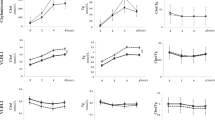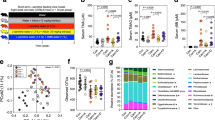Abstract
Objectives: To evaluate the effect of the red wine phenolic compound (RWPC) dietary supplementation without alcohol interference on: (1) some of the biochemical characteristics of LDL, (2) the oxidative susceptibility of LDL and (3) the antioxidant capacity of total plasma (Pl-AOC). In order to account for discrepancies between the three series of data, the in vitro stability of the association of phenolic compounds and LDL was tested. Design: An intervention study with 20 volunteers. Each served as his own control. Cu2+-oxidizability of LDL and Pl-AOC were tested on blood samples before and after dietary supplementation. Cu2+-oxidizability of LDL was also tested by co-incubation in the presence of RWPC or phenolic acids with or without extensive dialysis. Setting: The Laboratory of Lipid Biochemistry and Biology, School of Medicine, and the Laboratory of Metabolic Diseases, Lapeyronie Hospital, University of Montpellier, France. Subjects: Healthy males, nonsmokers and moderate drinkers, submitted to a dietary regimen deprived of vitamin E and C for a period of 10 d before supplementation. They also abstained from alcohol, wine, fruit juices, coffee, tea and cola beverages during this period. Intervention: Six 0.33 g capsules/d (namely two capsules at each meal) of a preparation of red wine phenolic compounds in a dry powder form were given to the volunteers over a period of two weeks. Blood samples were drawn in fasting conditions at day 0 and day 14 of the supplementation period. Results: Supplementation led to: (1) in LDL, a significant increase in vitamin E content (n=20, P=0.01) or vitamin E/total fatty acid bis-allylic carbon number ratio (n=20, P=0.006) without modification in the other biochemical characteristics or Cu2+-oxidizability; (2) in plasma, a significant increase in the antioxidant capacity (n=11, P=0.01). In vitro studies showed that RWPC or sinapic, caffeic or ferulic acids incubated in the presence of LDL increased the protection of the lipoparticle against oxidation (caffeic>sinapic>ferulic). This effect, however, was totally lost after extensive dialysis. Conclusions: The enhancing effect of the RWPC supplementation on Pl-AOC may be due to a phenolic-compound action both in the aqueous phase of plasma and at the surface of lipoprotein particles. Surface location possibly explains the enhancing-sparing effect of supplementation on LDL vitamin E and the absence of effect on dialysed-LDL oxidizability. Sponsorship: Supported by a grant from the Scientific Committee ‘Vin et Santé: Pathologies Vasculaires’.
This is a preview of subscription content, access via your institution
Access options
Subscribe to this journal
Receive 12 print issues and online access
$259.00 per year
only $21.58 per issue
Buy this article
- Purchase on Springer Link
- Instant access to full article PDF
Prices may be subject to local taxes which are calculated during checkout
Similar content being viewed by others
Author information
Authors and Affiliations
Rights and permissions
About this article
Cite this article
Carbonneau, MA., Léger, C., Monnier, L. et al. Supplementation with wine phenolic compounds increases the antioxidant capacity of plasma and vitamin E of low-density lipoprotein without changing the lipoprotein Cu2+-oxidizability: Possible explanation by phenolic location. Eur J Clin Nutr 51, 682–690 (1997). https://doi.org/10.1038/sj.ejcn.1600464
Received:
Revised:
Accepted:
Issue Date:
DOI: https://doi.org/10.1038/sj.ejcn.1600464
Keywords
This article is cited by
-
Positive association between plasma antioxidant capacity and n−3 PUFA in red blood cells from women
Lipids (2006)
-
Single and repeated moderate consumption of native or dealcoholized red wine show different effects on antioxidant parameters in blood and DNA strand breaks in peripheral leukocytes in healthy volunteers: a randomized controlled trial [ISRCTN68505294]
Nutrition Journal (2005)
-
Effect of red wine and red grape extract on blood lipids, haemostatic factors, and other risk factors for cardiovascular disease
European Journal of Clinical Nutrition (2005)
-
Bioavailability and antioxidant effects of olive oil phenols in humans: a review
European Journal of Clinical Nutrition (2004)
-
Total and corrected antioxidant capacity in hemodialyzed patients
BMC Nephrology (2003)



